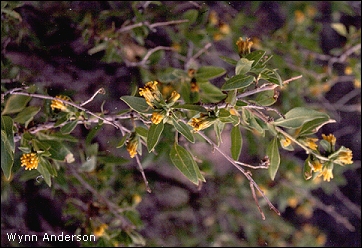

Spines and thorns and other things with sharp points are such common defensive structures in deserts that even the most naive soon learns to watch out for them. Plant parts that stab, rip, tear, or otherwise cause bodily harm advertise themselves, but another type of defense is more subtle. Tarbush, a plant considered to be a marker of the Chihuahuan Desert, is one of many desert plants that practice chemical warfare. To the eye, Tarbush is seemingly a harmless shrub. Yet, its leaves contain a variety of toxic substances quite capable of sickening and even killing sheep and other herbivores.
The danger is not entirely without warning signs for those who pay
attention, however. Smell and, especially, taste give a clear warning that Tarbush
leaves may not be a culinary delight. Nevertheless, in times of drought or on
overgrazed rangelands, herbivores may have little choice but to browse on this
shrub—only to pay dearly, even with their lives.

Listen to the Audio (mp3 format) as recorded by KTEP, Public Radio for the Southwest.
Contributor: Arthur H. Harris, Laboratory for Environmental Biology, Centennial Museum, University of Texas at El Paso.
Desert Diary is a joint production of the Centennial Museum and KTEP Public Radio at the University of Texas at El Paso.

Tarbush (Flourensia cernua) in bloom. Photograph by Wynn Anderson. Indio Mountains Research Station, Hudspeth Co., TX.